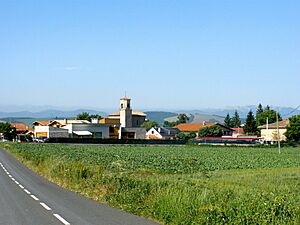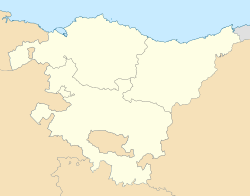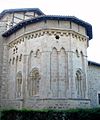Añua facts for kids
Quick facts for kids
Añua
|
|
|---|---|
 |
|

Elburgo municipality in Alava Province
|
|
| Country | Spain |
| Elevation | 564 m (1,850 ft) |
| Population
(2007)
|
|
| • Total | 31 |
Añua is a small village located in Elburgo municipality, in the Álava province of Basque Country, Spain. It sits about 564 meters (1,850 feet) above sea level. In 2007, about 31 people lived here, but the population has grown since then.
Añua is home to the ancient Nativity Church, built in the 13th century. This historic building attracts many visitors from nearby towns. You can also find old houses here, some with a traditional country style and others built in the 16th century.
The village has an old mill with a special mythological story. This tale is shared with children every Saint John's Day. It's about a miller who was trapped during a heavy rainstorm. He called for the "Galtzagorris," tiny magical creatures from the woods. These creatures helped him find his way home while singing. Today, people often visit Añua to watch a show that tells this story.
Añua also has fun celebrations, especially during Hallowe'en. The whole community helps to organize these events. The main village festivals happen on the first weekend of September, celebrating Nativity Day, which is Añua's patron saint day.
Contents
Nativity Church: A Journey Through Time
Añua's Nativity Church is a very old and interesting building. It was an important stop on the old Basque Santiago's Way, a famous pilgrimage route. The church is special because of its presbytery (the area around the altar) and its apse (a rounded part at the end of the church), both built in the 13th century.
Architectural Styles and Details
Experts believe the church's style mixes two old types of architecture: Romanesque and Gothic. This blend gives the church a unique look. You can see slim columns, thin decorative lines, pointed arches, and windows that are wider at the bottom. Even with its Gothic features, it still has some Romanesque touches. Look closely, and you'll find carvings of plants, animals, and people!
Changes Over the Centuries
The rest of the church was built later, with different parts added over many centuries.
- The main entrance door is Gothic and dates back to the 15th century.
- The nave (the main part of the church where people sit) and the Otazu-Guevera Chapel combine Gothic and Renaissance styles from the 16th century.
- The sacristy (where priests prepare) is Baroque and was added in the 17th century.
- The church tower was rebuilt in the 18th century.
Inside, two main artworks stand out:
- The large main altarpiece, which is a beautiful Baroque piece from the 17th century.
- The Saint Sebastian Triptych, a three-paneled painting from the Renaissance period in the 16th century.
Today, local people also create amazing handmade nativity scenes inside the church, which are very popular to see. Many tourists visit Añua to admire this old church, explore its surroundings, and learn about its long history.
See also
 In Spanish: Añua para niños
In Spanish: Añua para niños










